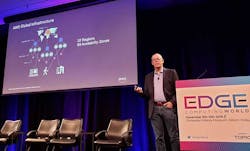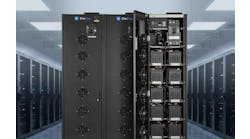The AWS Cloud Extends to the Edge, With Likely Boost for Colo Providers
MOUNTAIN VIEW, Calif. – Amazon is extending its cloud infrastructure to the edge, which means it will be doing more business with colocation providers and telecom carriers.
As Amazon Web Services pushes more aggressively into edge computing, its presence will also be felt by the growing edge ecosystem, including data center startups which have placed early bets on the growth of edge infrastructure.
Amazon’s ambitions were a key topic of conversation at the first Edge Computing World conference, which was held last week at the Computer History Museum in Silicon Valley. The event provided an early opportunity for edge specialists to assess how AWS may impact the market.
“It changes the dynamic,” said Jim Davis of Edge Research Group. “They have a lot of money and a lot of developers. It steers the discussion away from the smaller vendors who have been making headlines in this space. The startups are going to have to figure out where they can fit.”
With its rollout of its Outposts, Local Zones and Wavelength offerings at the recent reInvent conference, AWS has outlined how it will deliver edge computing services to customers, including enterprises, startups and consumers. Some of the new Local Zone capacity will be housed with colocation providers.
Amazon also introduced new ways to integrate its Alexa voice control tech into a far wider range of connected devices on the Internet of Things.
“What we announced last week was the largest change in architecture in many years,” said Adrian Cockcroft, the VP of Cloud Architecture at AWS, during a presentation at Edge Computing World. “I don’t even know where this goes. There will be new classes of applications.”
Analysts say other cloud services are developing similar strategies, and loom as potential disruptors of the emerging edge ecosystem.
“All the cloud providers see themselves as extensions of edge computing,” said James Staten, Principal Analyst at Forrester Research. “They’re trying to become the edge gateways. One of the biggest ways they’re gaining attention – and every enterprise should pay attention to this – is that they want (edge computing) as a service. Cloud vendors are driving this, and this is incredibly empowering for customers.”
Outposts, Local Zones and Colocation
Amazon’s Local Zones will provide low-latency access to AWS services in major metros. Local Zones will be deployed at colocation facilities, with AWS leasing space and managing fleets of its Outposts, which are racks filled with turn-key AWS cloud infrastructure.
Outposts were introduced to allow enterprises deploy hybrid clouds in their on-premises data centers, but will also serve as the building blocks for Amazon’s push into edge computing.
Am Amazon Web Services Outposts rack, which will serve as the building block for extending the AWS cloud to provide edge computing at on-premise data centers, colocation facilities and telco networks. (Image: Amazon Web Services)
Outpost racks are 80 inches tall, 24 inches wide, 48 inches deep, and can weigh up to 2,000 lbs. They arrive fully assembled, and roll in on casters, ready for connection to power and networking (see an overview video from AWS).
“We give you the same machines from the AWS cloud, wrapped up and delivered to you,” said Cockcroft. “There are applications that need to remain on premises. We talk to our customers, and they tell us what they want, and we go build it for them.”
Early Outposts customers include Phillips, GE Healthcare, NASDAQ, Lockheed Martin and VW, which is using Outposts in their production facilities.
“People want the same experience and pace of innovation,” said Cockcroft. “You order it, and in a couple weeks it’s delivered to your site. It takes a little longer because we have to move these atoms around. You’re renting the hardware, and paying for it roughly by the month.”
By using colocation data centers, AWS can deploy capacity more quickly and in smaller chunks that seen at its massive cloud facilities. AWS data centers usually house 25 to 30 megawatts of IT capacity, and span 150,000 to 275,000 square feet.
“A Local Zone is a building full of Outposts,” said Cockcroft. “We take a colo, put a large number of Outposts in it, and AWS manages it for a group of customers. The process for setting up a Local Zone is much easier than setting up a region. It’s a lot of work to get a Region in place. We can deploy a local zone much faster.”
AWS has recently deployed its first Local Zone in Los Angeles, targeting the market for computer animation and rendering for games and movies. These applications require fast connections between data storage and compute, and the Local Zone allows developers to shift capacity off-premises to AWS and retain low-latency access.
“We’re looking for concentrations of customers that are latency-sensitive,” said Cockcroft. He didn’t specify a standard capacity for a Local Zone. but said he anticipated that colocation space would meet Amazon’s needs in most markets.
Amazon Web Services has relationships with many colocation providers through Direct Connect. which provides secure on-ramps to AWS for customers spreading IT infrastructure across colo and cloud. Those network PoPs also support the AWS Cloudfront content delivery network.
As Amazon expands its Local Zones, it will likely be a more active customer for regional colo space, which could also offer opportunities for data center operators marketing their facilities for their proximity to cloud infrastructure.
Wavefront: AWS Meets 5G and Telecoms
At reInvent Amazon also introduced Wavelength, a software product that embeds AWS compute and storage services in the telecom network, enabling developers to use 5G connections to create low-latency apps for machine learning, virtual reality and Smart Cities.
“We’ve taken the cloud model, which is offered in tens of locations, and we’re taking it to thousands of locations, maybe even tens of thousands,” said Cockcroft. “This is potentially taking it several orders of magnitude beyond the cloud.”
Outposts will again serve as the building block for AWS to extend its platform, providing the hardware to run the Wavelength software. Verizon and other early-adopter telcos will deploy Outpost racks in their networks, and use them to offer cloud services to their customers. With Wavelengths, Amazon acts as the vendor to the telecom provider, who sells the services and owns the customer relationship.
“We are integrating our 5G Edge platform with Wavelength to allow developers to build new categories of applications and network cloud experiences,” said Kyle Malady, CTO of Verizon, who said AWS Wavelength will “unlock the full potential of our 5G services for customers to create applications and solutions with the fastest speeds and ultra-low latency.”
European telecom Vodafone, SK Telecom of South Korea and Japan’s KDDI are also working with AWS on Wavelength deployments.
“There’s been marketing announcements, but the reality is we have relationships with every major telco,” said Cockcroft. “It’ll be driven by the customers and applications. I would expect this to be a universal capability.”
Wavelength and Outposts also will create opportunities for working with business customers through fiber providers like CenturyLink.
“As this ecosystem develops, you’ll see many telcos partnering with many different clouds in different ways,” said Paul Savill, SVP of Core Network and Technology Solutions for CenturyLink. “At AT&T and Verizon, edge strategies are focused around 5G. We’re working with customers to provide fiber into their production facilities.”
Savill said CenturyLink could provide a customer with an Outpost at a nearby central office, and extend it to the customer premises. Bundled solutions could combine wireless and fiber connectivity with Outposts.
“I think you’ll see many Outposts deployed through partners like CenturyLink,” said Cockcroft. “It’s up to the telcos to decide how to build their business and bundles. With Wavelength, we’re a layer down in the stack.”
Outposts installed in Local Zones or telecom 5G networks will be assigned to an AWS Region to enable failover options. The region treats a collection of up to 16 racks at a single location as a unified capacity pool.
Greengrass and the Internet of Things
At reInvent Amazon also announced new features to extend AWS to connected devices, including updates for its Greengrass platform for the Internet of Things. Greengrass is an IoT gateway that allows developers to manage devices using Lambda, the AWS “serverless” computing technology.
Adrian Cockcroft, VP for Cloud Architecture at Amazon Web Services. (Photo: Rich Miller)
Last month AWS added container support for Greengrass, enabling developers to deploy and run Docker containers and applications on Greengrass-enabled devices. Amazon also made it easier to export data streams from edge devices, adding a Stream Manager for high-volume data collection from sensors and cameras. Stream Manager allows device managers to sort high-priority data into smaller datasets that can be sent to the AWS cloud for additional analysis.
“We’re seeing a huge increase in video as an incoming data feed,” said Cockcroft. “Cameras are everywhere.”
AWS has also reduced the resource footprint of its Alexa Voice Service, which an now run on devices with less than 1 MB of embedded RAM. Amazon says this will reduce the cost of producing an Alexa built-in device by up to 50 percent, and bring Alexa capabilities to devices that have limited local processing power and storage.
With services like Greengrass and Alexa, Amazon seeks to place the AWS cloud at the center of a growing universe of connected devices. As it extends its services to the edge, and to devices and sensors beyond, Amazon is showcasing the disruptive power of infrastructure.
“Industries are transforming around us,” said Asif Khan, the Engineering Lead for Alexa AI at Amazon. “You have the opportunity to place bets and keep up.”
The Road Ahead
Veteran observers of the data center sector expect AWS and its cloud cohorts will be important players in the edge computing picture.
“I think there’s a battleground on the edge,” said Dean Nelson, founder of Infrastructure Masons and advisor to a growing portfolio of startups. “Cloud guys will gain footholds. I really believe there will be a lot of startups and innovations that will disrupt the way edge evolves. I think there will be many winners.”
Amazon seeks to place the AWS cloud at the center of a growing universe of connected devices. As it extends its services to the edge, and to devices and sensors beyond, Amazon is showcasing the disruptive power of infrastructure.
With background in the cloud, colocation and telecom sectors, Ericsson’s Mark Thiele has seen a number of market transitions. He says Amazon’s focus on edge computing must be taken seriously by the rest of the sector.
“They’re a threat,” said Thiele, who heads Edge Cloud Ecosystem & Business Development at Ericsson. “I think their bet is they can take this over because most of this will be built on technologies that don’t need VMware.”
But like Nelson, Thiele sees plenty of business to go around. “I believe the fractured nature of the edge will create opportunities for a long time to come, beyond the top three to five cloud guys,” he said.
Jim Davis of Edge Research Group agrees, and points to other markets AWS has entered.
“AWS offers cloud CDN, but that doesn’t mean that Akamai hasn’t made billions of dollars with new services,” said Davis. “There’s still ways to differentiate, and it’s good that Amazon is here, because it will draw more attention to edge computing.”






